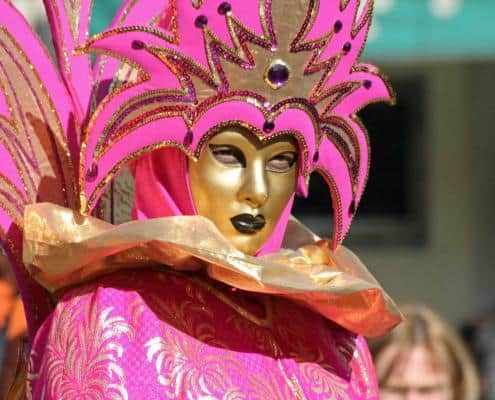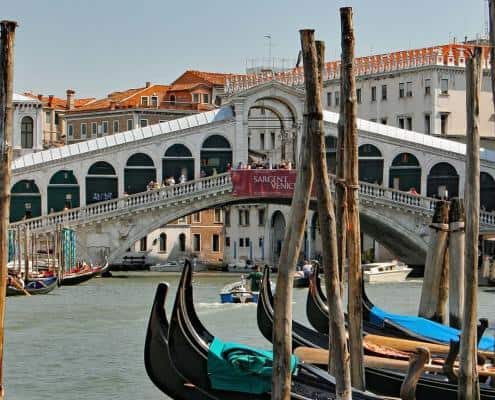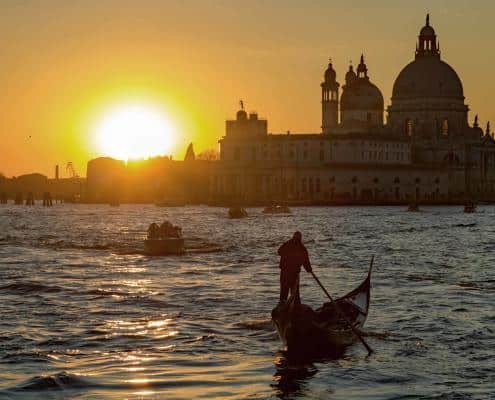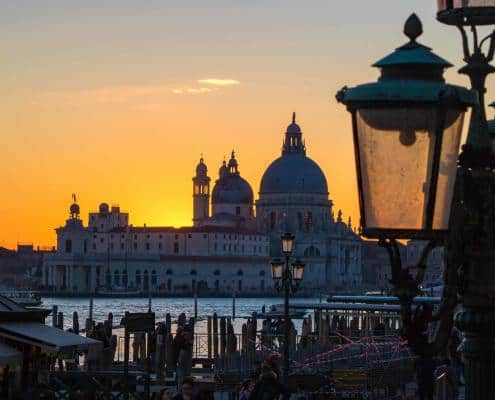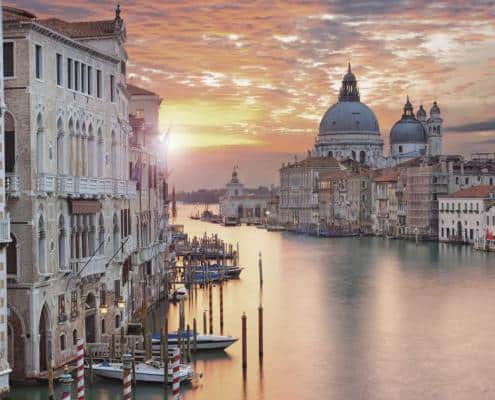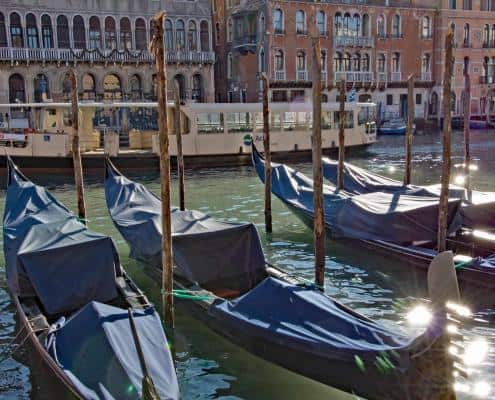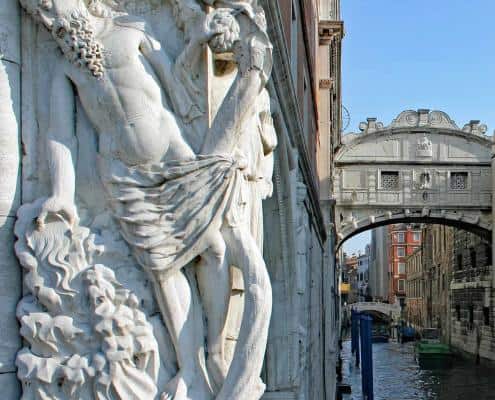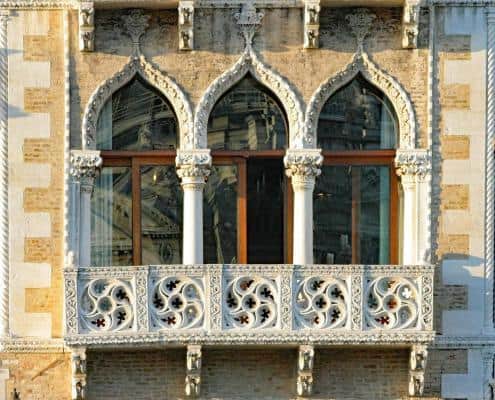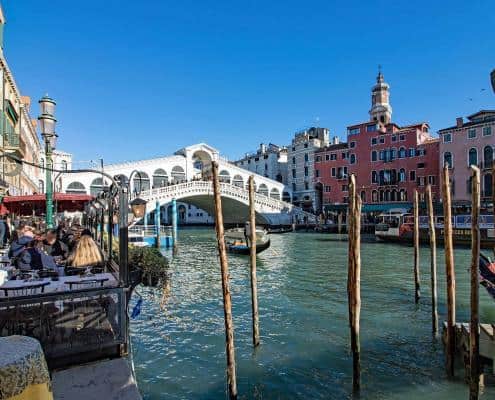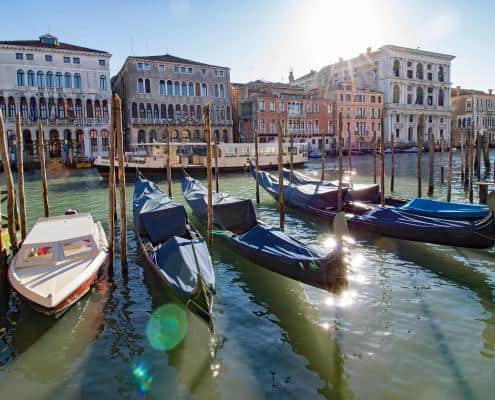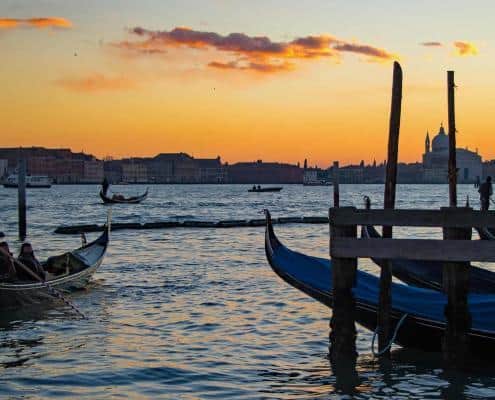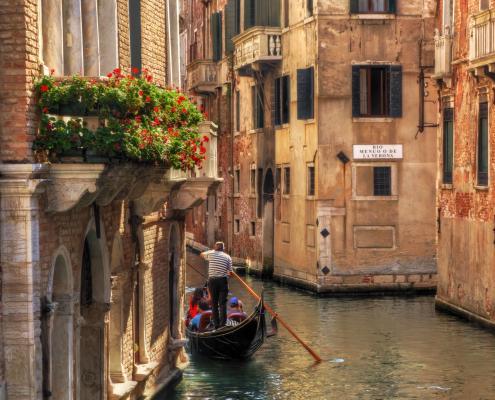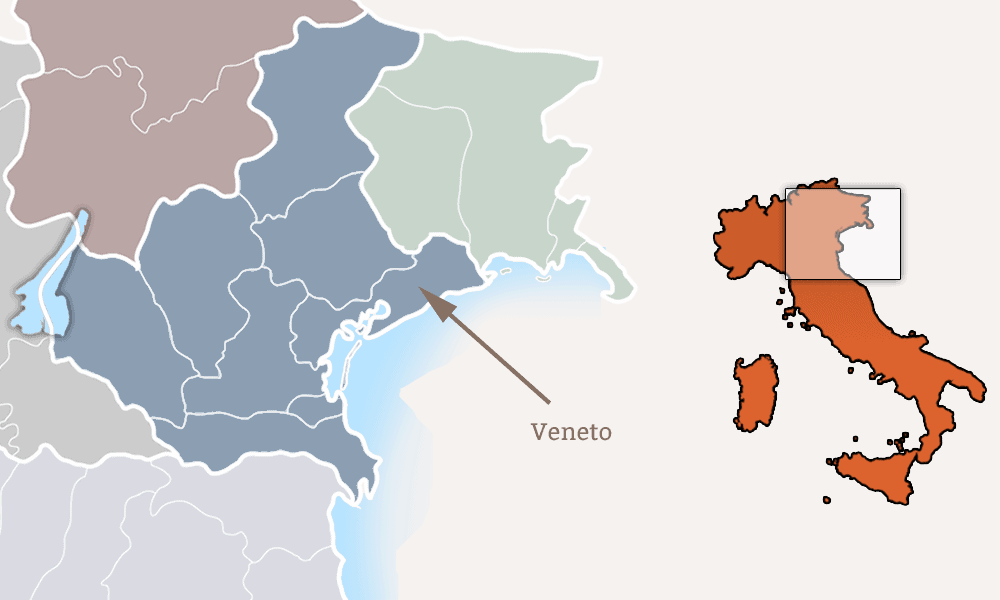Venice in Italy
In Italian: Venezia
The romantic Venezia can only be enjoyed if you are quartered for a few days and experience Venice at night. When the alleyways go quiet and you end the day with a glass of wine in one of the small bars in the hidden squares, It is the best time of the day in the lagoon.
Venice’s palaces rest on wooden poles that are rammed into the lagon floor. Most are connected to a walk way on one side and to the canal on the other side which can be reached then by boat or gondola. This unique experience can only be found in Venice, where you can even go to the theatre by gondola.
What to do in Venice
St. Mark’s Square (Piazza San Marco)
St. Mark’s Square is the tourist center of the city. A “must see” for everyon. Here stands St. Mark’s Cathedral and the bell tower, the Doge’s Palace, the famous cafes, the showroom of famous glass blowers, very beautiful jewellery shops and a postcard view of the lagoon.
The most beautiful photos of Piazza San Marco can be seen from the water or opposite the lagoon, from the forecourt of the Chiesa di San Giorgio Maggiore.
Venice for a Day
We’ll give you tips on how to get to know Venice in one day. If you have less time, we recommend a privately guided tour where you see the main sights of the romantic city in the lagoon.
The best way to get to Venice is from Santa Lucia train station. When you get out of the train station, you are already standing on the Canal Grande and are overwhelmed by the hustle and bustle and the beauty of Venice. This is also where the landing point for the “vaporetti”, which crosses through Venice like regular buses, is located. There is heavy traffic on the Canal Grande, like on a busy street, only motorboats and gondolas are cruising the main street of Venice.
We go via Ponte Scalzi to the other bank of the Canal Grande. The church of Santa Maria di Nazareth is located here. Through the Sestriere San Polo, we pass the Church of San Rocco and Campo San Polo to Piazza San Marco (St. Mark’s Square), the heart of Venice. If the queue is not too long, we recommend climbing the bell tower to enjoy a wonderful panoramic view of Venice from a height of 60 m.
To visit the Basilica of San Marco in St. Mark’s Square, it is advisable to get skip-the-line tickets in advance. This also applies to the Doge’s Palace (Palazzo Ducale), the former seat of government of the Maritime Republic of Venice.
The prison “I piombi” was located behind the Doge’s Palace. It was separated by the canal. The prisoners had to use the small covered bridge when they were brought across the canal from the Doge’s Palace to the prison. The name Bridge of Sighs – Ponte dei Sospiri comes from this time. When visiting the Doge’s Palace with the museum, you can walk over the Bridge of Sighs into the narrow cells of the prison.
We continue to the Teatro La Fenice, the famous opera house in Venice, which after several fires has risen from the ashes like a phoenix every time. The theater can be visited with an audio guide or on a privately guided tour.
During our stroll through the narrow streets, we come to the Cannaregio sestiere with the Basilica of Santi Giovanni and Paolo. This is followed by the Venice Hospital. The rescue ships are parked in front of them, as the ambulance in Venice is logically also carried out by boat.
In the Sestiere Cannaregio, the typical Venetian life takes place with beautiful restaurants and osterie, which are also frequented by the locals and where you can drink an “Ombretta” (Prosecco) or a “Spritz” in peace.
The Jewish ghetto in the Cannaregio sestiere is definitely worth seeing. The way back to the train station is easy to find thanks to the signs to Stazione. Following the flow of people, the path automatically leads to the Ponte Guglie bridge, the only bridge in Venice with three arches.
Doge’s Palace (Palazzo Ducale)
A tour of the Doge’s Palace takes you to the Higher Council Hall (Sala del Maggior Consiglio) on the first floor of the palace with 1250m2 of phantastic seamless terrazzo floor. It was a very special art to make such floors. They are cast in place and then ground and polished. Above it a coffered ceiling, which can also be visited from above. Take a good tourist guide who explains all this to you, lead you across the Bridge of Sighs and into the prison cell of Casanova. An interesting story.
Venice Jewish Ghetto
The first Jewish ghetto in Europe, the Campo Ghetto, was established in Venice. It is located in the Sestiere Cannaregio district.
At the beginning of the 11th century the first Jews settled in Venice, and their number continued to grow over the years. A decree of the Republic of Venice of March 29, 1516 stipulated that the Jews had to live in a demarcated area of Venice. The area of the foundries was chosen for this, called “geti” in Venetian. The Jewish ghetto was locked at night while Christian guards monitored compliance with the curfew. The result was the first ghetto in Europe with Jewish schools and synagogues as well as shops and restaurants that offer typical Jewish products and dishes.
Palazzo Contarini del Bovolo
No, there is no shortage of palazzos in this city. Some are used as a museum, some are publicly owned and many are still inhabited.
The Palazzo Contarini del Bovolo stands out. His external stairwell gave him the name Snail Palace (Palazzo Contarini del Bovolo). It can be visited. You walk up the spiral staircase to an arcade with beautiful views over the rooftops of Venice.
Teatro La Fenice
This is the most famous opera house in Italy. It first opened with this name in 1792 after being rebuild on the ashes of another opera house. It burned down twice again and what we see now is the splendid reconstruction that completed in 2004. We offer 3-day music trips to Venice including hotels, premium tickets, and an exclusive program.
Rialto Market
The Rialto Bridge, which crosses the Grand Canal, is crossed by every visitor to Venice. It is lined with small shops offering all sorts of tourist products. If you stand on the bridge and look towards San Marco, you can see a number of restaurants on the right and left with tables right at the water’s edge. Expensive, bad foood, tourist trap might be the first thought. But we’ve tried some of them recently. The food is delicious, the service is very friendly and it is not overpriced. You only live once.
At the bridge is also the market square with fresh fish in the morning. In the evening there is also the very affordable typical aperitif. Spritz. White wine with a bit of Aperol (red, bitter liquor) a dash of soda (the spritz in the name), a slice of orange and ice cubes in summer.
Basilica dei Santi Giovanni e Paolo (Cannaregio)
What a magnificent church building that looks out over a large forecourt, the Campo dei Santi Giovanni e Paolo. At the side is the Scuola Grande San Marco, which now houses a large hospital. The library is worth seeing. The basilica is huge and spacious. Even the floor is a splendour. Numerous monuments and paintings are witnesses to a noble time. It all came about 400 years ago.
The interested visitor is well advised to hire a licensed tourist guide.
Venice Carnival
Even Casanova loved the carnival, in which his playmates, hiding behind a mask, could indulge in lovemaking unrecognized and uninhibited.
The Venetian carnival is one of the most famous in the world with its long tradition since the times when Venice was still a maritime republic and a little has remained of the colorful spectacle to the present day, when Venice and its guests transform for the mad days.
Venetian masks
In Venice, masks were not only worn at carnival. Also to official banquets and large festivals of the maritime republic of Venice was the wearing of masks a custom. The carnival mask prevented one from being recognized when begging, because this was quite common when, for example, patricians were impoverished and disguised themselves as beggars to collect a little cash.
Their peak time came with the Venetian nose masks during the plague epidemic. Doctors and aides tried to protect themselves from contagion by putting on the masks.
Venice Biennale
The biennial traditionally takes place on the grounds in the district (sestiere) of Castello. The art exhibition takes place every two years from May to November. Alternating with the art bienniale in the odd years, an architectural biennial takes place on the Giardini exhibition grounds in the even years.
In addition, there are other annual events such as the music festival, the film festival as well as a theatre festival and a dance festival.
Venetian glass art
While strolling through Venice, the beautiful glass objects stand out in the display cases. The glassblowing craft on Murano is unique and world-famous. Glass from Murano is one of the exclusive artisan products. Glass making began its journey to Europe from Venice. The glassblowers from Murano are famous since the 14th century for their special abilities .
From Venice you should not bring just any souvenir. It should be a piece of jewelery or a jar or vase made of Murano glass. Leave the plastic gondola made in China behind.
Venetian gondolas
What would Venice be without its gondolas? With a bit of luck, you’ll meet a singing gondolier on the Grand Canal. The prettily dressed gondolieri with their straw hat take their guests with the gondolas through the quiet canals between the city’s palaces.
Treat yourself to a ride in such a piece of jewelery, handmade by local craftsmen and elegantly decorated.
Culinary Experiences
Venetian cuisine is very versatile between fish and meat, along with vegetables. A few typical Venetian dishes, for example, are
- A soup of pasta with beans and seafood
- Risi Bisi, a risotto with sugar peas
- Calf liver in Venetian style
- Dried cod, baccalà
- Sarde in Saor, a dish of anchovies, raisins and onions
- At Christmas the Pandoro cake
The typical aperitif is the spritz. Wine, soda, Aperol. In addition, the Veneto has excellent white wines, which we value throughout Italy.
How to get to Venice
How to get to Venice
By air
Venice has an airport from which you can easily reach the Most Serene Republic of Venice by regular water taxi. This was the name and title of Venice from the 7th to the 18th century. If you have booked a 5-star hotel, you will be picked up at the airport by water taxi. Otherwise, a vaporetto, the bus on the water, goes directly to San Marco Square. Ali Laguna is a private “airline bus” company whose tickets are not valid for the public vaporetto.
By train
The train connections are very good. The is also a high-speed train-system once you are in the country. Within Italy you travel very well from north to south and east to west on a high-speed train with many different names. However, the connections to neighboring, northern countries are not yet with the fast trains. The Alpine Mountains are bothering and the current government is on the brakes, even though the European Union wants to pay half of the tunnel costs.
Be that as it may, a train ride takes you right in the middle of the city, where life is playing. Santa Lucia Train Station is located right on the Grand Canal. It’s always overwhelming to step out of the station and experience full Venetian life on the Grand Canal like a spectacle.
Right in front of the train station you can take a water taxi to arrive at your hotel with elegance. You can also travel on with the vaporetto, but then have to take care of a ticket (many different fares) and hustle a bit in the “Rush Hour.” Baggage better little and with wheels. The luggage also needs a ticket. If you have little luggage and are well on foot, then you can also walk to the centre in half an hour.
By car
The last option is to arrive by car. A long bridge takes you to the island of Tronchetto with the huge parking lot under the sun or to the multi-story car park. You leave the car for the entire time of the stay there. The additional costs of about €25 per day are to be considered.
From Tronchetto you can take the vaporetto, a kind of water bus with which you usually get around Venice. New is a monorail that leads from Tronchetto to the railway station square-Piazza Roma. The monorail is called “peoplemover”.
The cruise ships dock at the port between Tronchetto and the Sestiere Dorsudoro.
Venice to begin charging tourist entrance fee
The entrance fee to Venice is still to be decided. 2019 is still a transitional year with discounted tariffs. From 2020 it will be up to business and it is not easy to see through now.
From 1 January 2020, admission staggered will be €3 to €10 depending on the season. For events such as Carnival, where the city is always overwhelmed by tourists, €10 can be expected, in the low season (December, January) it will probably be only €3 per person.
The problem has arisen in particular from the cruise ships, where up to 5000 people disembark at a stroke and flood the alleyways. This type of tourist is particularly hated by the city fathers. The ships destroy the building base with their currents and the day tourists leave their garbage there without consuming accordingly.
Practical tips
In Venice, the neighborhoods are called Sestiere and there are no house numbers in the usual system, but an ongoing numbering of the buildings. This takes some getting used to when looking for the property.
In Venice there is a large hospital and of course also an ambulance service and fire brigade, which, who is surprised, approaches by boat on the water.
For the vaporetti there are not only the single tickets, but also 12-hours or tickets for several days. This is worthwhile if you stay for several days.
In early 2019, the government decided to demand entrance fees from tourists. Exactly how this works and what it costs is not known at the moment. We’ll go there.
Sestiere Districts
Venice is divided into 6 neighbourhoods. In Venice, these are called Sestieri after the number 6. The signs placed in the alleys show which district you are in and thus facilitate orientation.
These are:
- The most famous is the Sestiere San Marco (St. Mark’s Square) on the Grand Canal. It forms the cultural center of Venice.
- Sestiere Cannaregio is located in the north. Here are Santa Lucia Station, the Jewish Quarter and the hospital in the Santi Giovanni and Paolo complex.
- The Sestiere San Polo is enclosed by the arch of the Grand Canal. The Rialto Bridge connects San Polo with San Marco.
- The Sestiere Santa Croce is known to ship sancmmeters. Here is the port for cruise ships.
- Sestiere Castello in the east is less touristy. It is home to the Arsenal and the Venice Biennale exhibition area.
- Sestiere Dorsoduro in the southwest is accessible via the Accademia bridge or by gondola. Here you can visit the famous Peggy Guggenheim Museum.
Excursions to the islands
Venice is, in fact, a city of composite islands, a total of 120 islands. The main islands are:
- Tronchetto, the park island
- The holiday island Lido with the beautiful beaches
- Murano, the Island of the glassblowers
- Burano with colourful fishermen’s cottages and cosy restaurants
- Torcello, a tiny island opposite Burano with the Basilica di Santa Maria Assunta that has some byzantine mosaic floor
- Giudecca with the long promenade with restaurants
- San Michele Island, the Cemetery with the graves of famous people (some graves have power sockets to charge the mobile phones – no for electric christmas trees)
- San Giorgio with the Palladio Church and postcard views of San Marco
- Vegetable garden Island Sant ‘Erasmo
- Lazzaretto Nuovo, the quarantine island at the time of leprosy
There is, of course, something interesting to write about every island. We will add to that.
Discover the Best Places in the Veneto Region
The Veneto region has numerous cities and places worth seeing. There is Verona, the city of lovers or Padua with the famous Scrovegni Chapel. You can drive through the vineyards and taste the Prosecco that is grown here. The best way to travel is on the Brenta Canal from Venice to Padua and take this opportunity to get to know the Renaissance villas, which have become world famous under the name Palladio Villas and are a UNESCO World Heritage Site.




